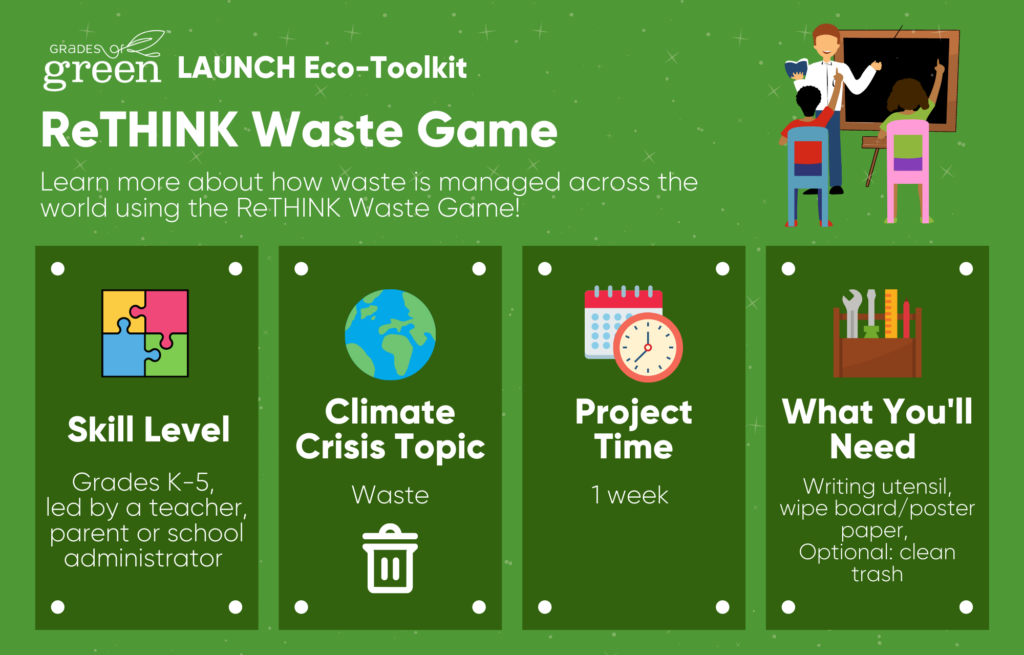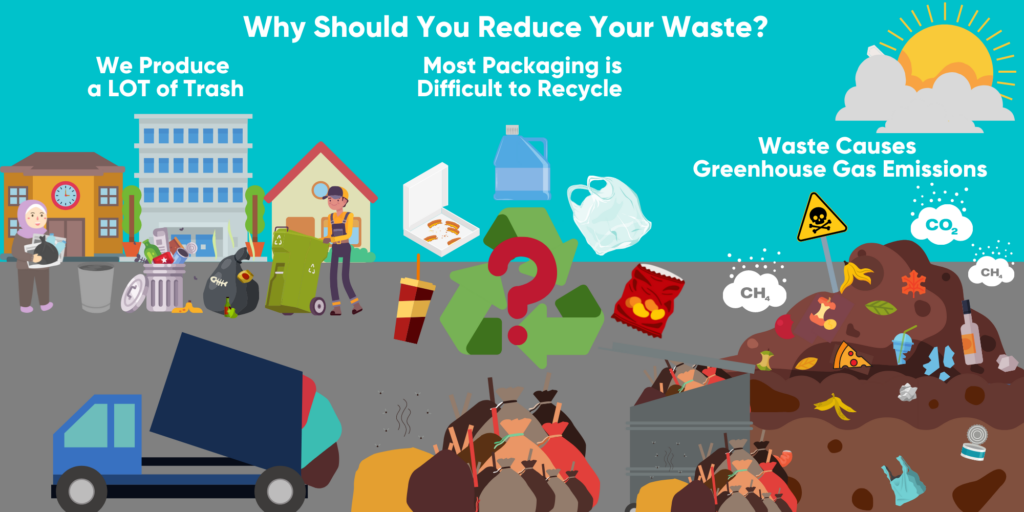Defeat the trash monster by reducing your waste!
Our landfills are filling up at an alarming rate, often with resources that can be reused, recycled, composted, donated, or better yet: not even used in the first place. We are running out of space to put waste in our landfills. Play the ReTHINK Waste Game to take action on reducing landfill waste!

Toolkit Details


NGSS
This toolkit address the following Science and Engineering Practices (SEPs) within the Performance Expectations of NGSS for Grades: K-2 and 3-5
- Asking Questions and Defining a Problem
- Analyzing and Interpreting Data
- Constructing Explanations and Designing Solutions
- Obtaining Evaluating, and Communicating Information
Learning Objectives
- Analysis
- Students will analyze how waste is managed and its impact on the environment
- Project Management
- Students will exercise effective communication and accountability
- Evaluation and Assessment
- Students will assess the impacts of waste on the environment and determine the best outcome to manage waste
Why It’s Important
Learning about the impact of waste is important to the environment because it allows you to make informed decisions on how to manage your resources and minimize waste.
What You Will Accomplish
Students will learn the impact of waste on the environment and how to classify waste categories by playing interactive games.
Educator Project Plan
Follow the steps below to set up a successful ReTHINK Waste Game at your school! Need help? Contact us!
Track your metrics and submit your impact after implementing this toolkit. Your feedback helps keep our programs free for all across the globe.
Determine Participants
Divide your class into groups or pairs.
Why Should You Reduce Your Waste?
The resources provided can be shown as a slideshow or printed out as individual worksheets for students to learn.

We Produce A LOT of Trash
Our landfills are filling up at an alarming rate, often with resources that can be reused, composted, donated, recycled, or not even used in the first place. We are running out of space in our landfills, which stresses the importance of reducing the amount of waste we produce. [1]
Most Packaging is Difficult to Recycle
Most packaging is difficult to recycle because it is made with hard to recycle materials like plastics or is contaminated with leftover food. Of the 14.5 million tons of container and packaging plastics produced in the US yearly [2], less than 9% of it is actually recycled. Even when we put plastic in the recycle bin, most of it will still end up in a landfill. This plastic packaging is made from oil, a natural resource that requires energy to produce and release greenhouse gasses that cause climate change throughout its lifecycle.
Waste Causes Greenhouse Gas Emissions
Everything we buy and throw away including clothing, electronics, single-use plastics, and food has a large environmental cost. The manufacturing, distribution, and use of the goods and food we rely on most – as well as management of the resulting waste – all require energy, which mostly comes from fossil fuels. [3]
Watch these two short videos to learn why it’s important to reduce waste!
Think About It!
Pre-Activity Questions
- What are the different waste bins you use at home?
- What materials should be thrown in the landfill?
- What materials should be recycled?
- What materials can be classified as organics?
Take Action: How to LAUNCH the ReTHINK Waste Game
Lead students through the ReTHINK Waste Game with guided instructions. Check out “Pro Tips” with each step for useful help:
1. Gather Participants
Determine who and how many students are participating.
- Divide students into groups and allow them to collaborate with each other on each of the games.
2. Prepare Your Materials
Gather the following materials and give them to participants to use for the ReTHINK Waste Game.
- Handout of waste items
- Cards for each student team with 3 different colors to represent trash, recycle, and organic waste (organics is optional, if applicable to your school)
- Pictures of waste items (attached)
- Waste timeline handout (attached)
- Poster paper or wipe boards
- Writing utensils
- Optional: Clean trash
Bring in clean trash from your school so students know how to manage the waste they encounter everyday.
3. Game A: What Bin Does It Go In?
Students will collaborate to decide how to sort waste items, learning which items can be recycled or diverted from the landfill, and what must be thrown away.
- Have your students form teams or work together at their tables. Using the list of waste items, instruct the teams to decide as a group which bin each item goes in. Pass out color cards to each team and explain that *Blue is for Recycling, Gray is for Landfill, and Green is for Organic waste (optional). (*colors may vary!)
- Hold up a picture of each item or call off the items from your list. Instruct the student teams to hold up the color of the bin where they would place the specific piece of waste.
- Share correct answers from the answer key.
4. Game B: How Long ‘Til It’s Gone
Students will collaborate to estimate how long waste items take to break down in a natural environment and gain an understanding of why recycling (and composting, if applicable) is important.
Background: Much of what we make, use, and discard lasts for a very long time. Items sent to a landfill will last even longer than those in a natural environment. This is because the dry and oxygen-poor conditions found in modern landfills cause organic matter to mummify rather than decompose. When left in a natural environment, many items will eventually decompose. Fossil fuel derived plastics will simply break down into smaller and smaller pieces known as microplastics, which will pollute our soil and waterways indefinitely.
- Distribute the waste picture cards to each team of students. Instruct students to look at the pictures and discuss how long they think each item will last before they break down or decompose.
- Ask students to then create a timeline by ordering items based on how long it will take to break down. Show timeline handout as a reference.
- Lead a class discussion on the timelines they created. Share correct answers (see answer key).
5. Game C: Brainstorm!
Students will think about how to apply what they’ve learned from this lesson into their lives.
- Ask each team of students to brainstorm alternatives or reusable items that can replace single-use items. Encourage students to get creative with ideas and think of ways to repurpose items they already have.
- Instruct students to write their ideas on poster paper or wipe boards to share with the class.
- Have each group share key observations or interesting alternatives with the class.
Reflection Questions
How’d It Go?
- What changes in your daily life can you implement to reduce your waste or divert waste away from landfills?
- What was the most interesting or surprising fact that you learned from this lesson?
- What would you say to educate a friend or family member about reducing waste?
Report Students’ Impact
Congratulations!! You’ve played the ReTHINK Waste Game! Don’t let all that hard work go unnoticed. Submit your results by clicking the green button below.
Project ongoing? No problem! Let us know what you’ve done so far.
By reporting your impact, Grades of Green can:
- CELEBRATE and elevate your students’ hard work and success.
- Offer our programs FREE for all students across the globe.
- AWARD stipends and certificates to hard-working educators and students.
Please take a few minutes to submit your results. Thank you!
Provided Resources
- ReTHINK Waste Game Lesson Plan
- ReTHINK Waste Game What Bin Item List
- ReTHINK Waste Game What Bin Picture Cards
- ReTHINK Waste Game How Long Timeline
- ReTHINK Waste Game How Long Picture Cards
- ReTHINK Waste Game How Long Answer Key
- ReTHINK Waste Game Wrap Up Form
- ReTHINK Waste Game Slideshow
- Toolkit Resources – Google Drive Folder
Congrats on completing the ReTHINK Waste Game Eco-Toolkit!
Did you enjoy this toolkit? Find your next project here!